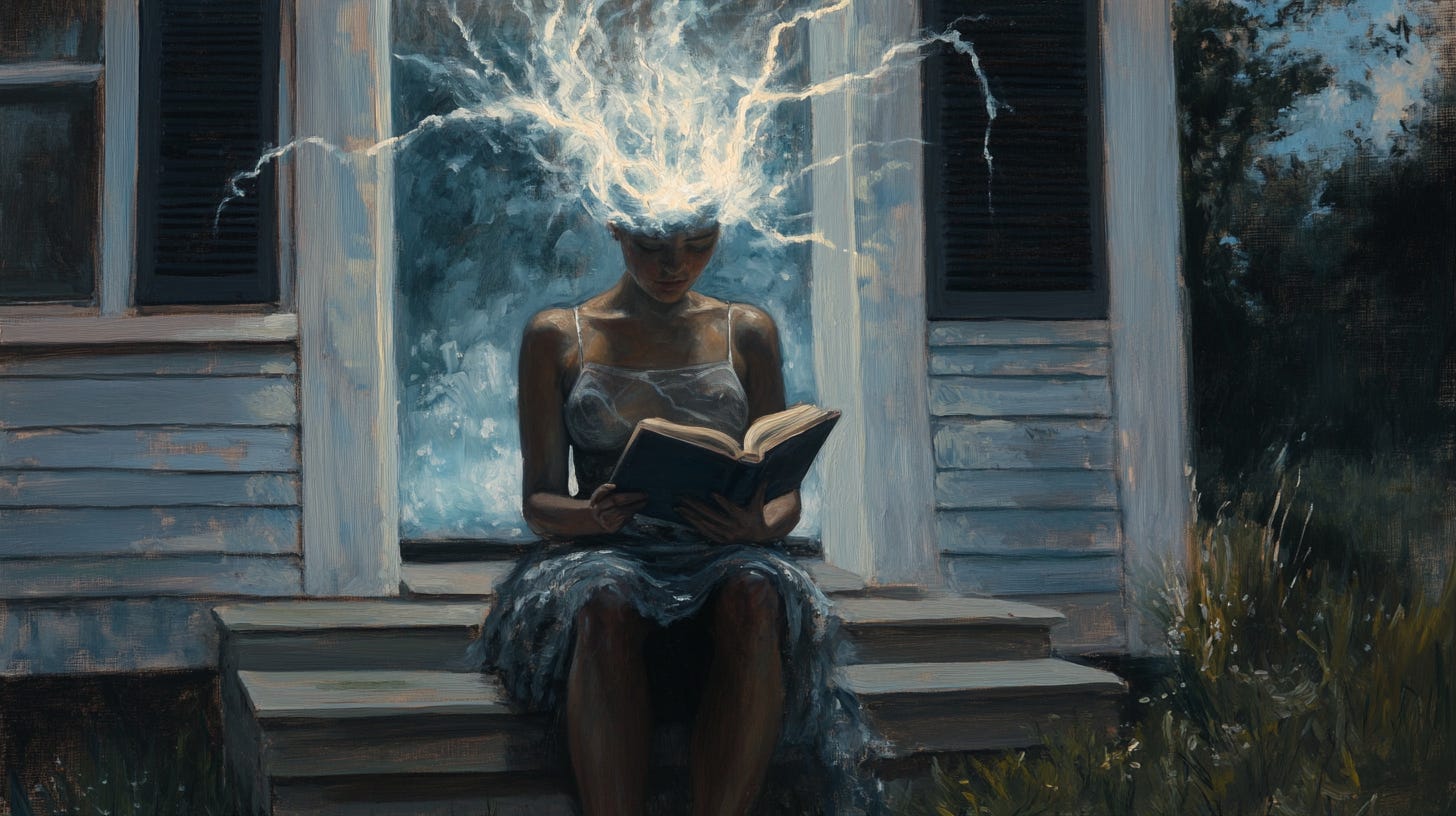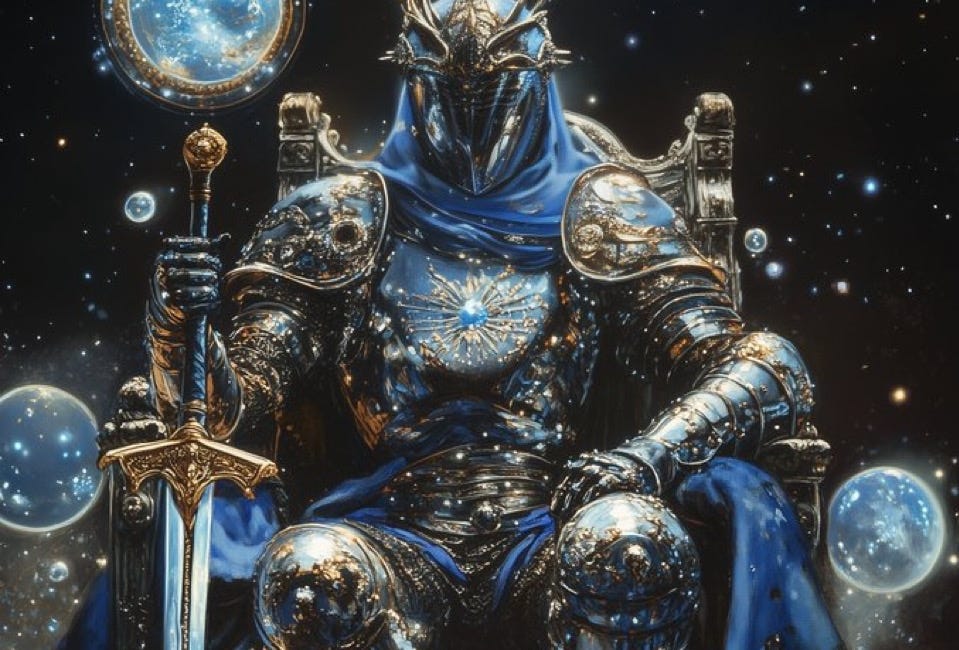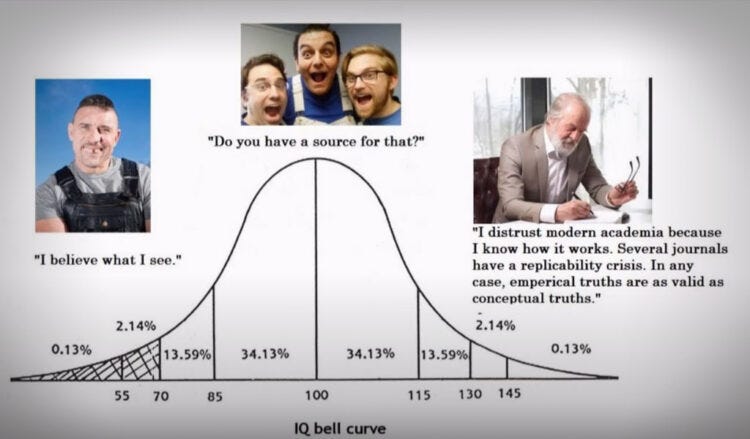Conceptualizing the Collective Unconscious of a People
A rationalist take on concepts like the noösphere and the global collective unconscious and how those ideas fit into modern cultural decay
The following article is written as background for future explorations of psycho-social metaphysics. The nature of human societies and how those societies interpret reality, their Gods, and their place in Creation. Hopefully this can work get the gears turning regarding post-liberal spiritualism in a way that is enlightening and intellectually honest.
What is a Rationalists Take on the Collective Unconscious?
It’s tricky to discuss metaphysical concepts in the context of material physics, biochemistry and psychology. The hyper-rationalism of modernity has rendered complex what was once taken as general wisdom. Conventionally, beliefs in demons, ghosts or psychic phenomena requires a structural rejection of observed clinical reality. Likewise, atheistic or agnostic materialist views of reality as based on physics and the scientific method require the rejection of spiritual forces: demons, ghosts, gods psychics, and similar paranormal constructs.
There is now (mid-2020s) an informal field of study focused on such incompatible ideas in parallel. That is, to acknowledge the sciences as objectively accurate in detailing physical and biological reality, while recognizing the extreme limitations of the hard sciences when it comes to understanding complex emergent phenomena. In modern metaphysics there is occurring a glacially slow mixing between materialist rationality and spiritual metaphysical complexity. One can note that a number of clinical psychologists have been mixing psychological framing with theological framing. A number of anthropologists have been acknowledging spiritual components to psycho-social reality.
One may acknowledge the atheists view of theology, “man in the sky with a white beard telling you to be a good boy,” as a willful misinterpretation of spiritual truth. Specifically a willful failure to understand Truth by a group of atheists with a grudge against conventional organized religion.
Materialists Have Not Slain God: Truth is His Restoration
Recently I had a conversation with a number of like-minded and well educated individuals. I found that they tended to fall into two camps depending on upbringing: Theological and agnostic. None were actual atheists, and depending on world view, several would be best described as absolutist theists. The existence of God, as a moral higher power, appears …
A new approach to religion acknowledges it not merely as a set of irrational beliefs, but as a set of principles for community organization. Historically, religion has been a solution to the midwit problem:
We live in a world where midwit interpretations of theology are the most dominant. In the sciences this is taken as treating all forms of emergent mysticism as “theological nonsense.” Among the the small “paranormal” or “witchcraft” subcultures, it takes the form of trying to curse one’s enemies with nonsensical rituals or appeals.
Neither is the approach taken here. Rather it is an interpretation Brights and Dimwits have both observed: The theological is a means of describing very real emergent psycho-social phenomena that occur in groups of people. Ideologies as possessing demons that take control of a persons spiritual self and drive it to destruction. The forgiveness of God as a mitigating force that spiritually uplifts a community. Ancestors and gods and community spirits are representations of cumulative psycho-social health. To kill God is to condemn ones society to suicide.
For years we've been defining psychology, sociology, and theology as different disciplines when they aren't.
The Material Collective Unconscious or Noösphere
There is the individual mind, each of us has one (presumably). Depending on ones skill and sensitivity, communicating with other people contains an enormous amount of information, far more than mere spoken words: intonation, physicality, facial expression, micro expressions, body language, etc. The result is an overall vibe that one gives off. Communications via the unspoken, that is, the unconscious aspects of the self. That information is absorbed by those around you and subconsciously understood. Once assimilated, information is added to the personalities of others, modified, and re-transmitted; repeaters altering the collective unconscious state through repetition. The smaller the group, the more specific and and complex this collective unconscious group-mind can be.
There is a hazy barrier between the individual subconscious and a groups collective unconscious. It is easy for an individual to be uplifted or dragged down by the collective thoughts and will of surrounding peoples. A small group of players at a sports arena can uplift a specific player or tear a specific player down based on their collective unconscious thought. This is why those teams that believe they are winners tend to win more frequently in sports than those that do not. This phenomena has been observed and catalogued by social psychologists on multiple occasions. It’s easier to quit a drug if attempting so surrounded by other people equally stalwart in their desires to end dependencies.
The point of note is the hazy line between the individual subconscious and the local collective unconscious. Likewise, there’s a hazy line between the local collective unconscious and the cultural or microultural unconscious. At each layer “down” the information encoded becomes less precise, and more difficult to change.
At the level of a culturally homogeneous city or town, the collective unconscious leads to unique practices and modes of thought. At the level of an ethnic collective unconscious, the modes-of-being fundamentally structure a society. Strong ethnic groups with a strong collective unconscious form asabiyah over generations that can build toward amazing feats of exploration, conquest, and cultural development.
One does not need to believe in psychics or spirits to understand that there is a human collective unconscious that forms a sphere of low-density information across continents. The collective unconscious shifts world events in ways we scarcely have the capacity to understand. The noösphere is a philosophical concept that represents the information collective. Its existence was an idea developed and popularized by the Vladimir Vernadsky and philosopher and Jesuit priest Pierre Teilhard de Chardin.
A rationalist interpretation of the collective unconscious posits that it exists in ambient arrays of information that individuals carry and transmit to each other through non-linguistic methods. Not only does that definition seem to soundly represent a reality that large-data-science is now tapping into, it also contains interesting side-effects. The proposed non-sentient World Mind of humanity is made up of sub-minds in the form of civilizations, ethnicities, cultures, nationalities, localities and individual microcultures. Each groups group unconscious contributes to the whole, while being distinct things. In the same way that the individual subconscious is fuzzy around the edges and bleeds into the local culture.
From this perspective, ideas like the collective spirit of a people start to make sense. Simultaneously, possessive and destructive ideologies mix with the theology of demons; self-destruction as metaphor for emergent action. As an individual can suffer trauma and psychological scarring, a society can suffer trauma and scarring through its collective unconscious. At every layer you have the potential for bad ideas to become incumbent on an unwilling population. Ideas that sweep through the collective unconscious of a people can exist for good or ill. Sufficiently powerful “demonic” ideas can possess individuals to harm themselves and loved ones, enlightened ideas can build entirely new civilizations and modes of being.
From the position of a rationalist, a healthy collective unconscious can make a people vigorous, strong, and righteous. A sickened collective unconscious can make a people weak and cowardly. A city of depressed individuals dragging one another down and standing in one another’s way is going to create an environment where even exceptional individuals are swayed toward ineptitude and laziness.
At a global level, the rate of transmission is limited, but at the level of a civilization, the spirits hidden in the collective unconscious can have significant effects. The tidal forces of the collective unconscious in this way represent classically theological elements.
The Effects of the Collective Unconscious
The World Mind or collective unconscious is a psycho-social phenomena that subtly pervades every human society. So much so that it’s rarely something people consider as few people in modern history have ever been partially or totally cut from it.
Recognizing the effects of the collective unconscious, and the need that most humans express for connecting with it, it’s possible to make a number of statements about societal structure and decay. The world-mind “thinks” very slowly. Much of the crucial information transmitted between individuals takes the form of non-verbal statements. Or in modern parlance: vibes. For some one to absorb this information, unconsciously comprehend it, and retransmit it takes time. Minutes or hours in most cases. At a global or civilizational level, the collective unconscious is very slow to gain new ideas and very slow to drop old ones. For a sufficiently massive population, decades are entirely reasonable. Civilizations shift slowly most of the time. New ideas build a pressure in the unconscious demanding change long before they’re observed.
Microcultures
Microcultures and highly insular ethnic groups (Amish or Hasidic Jews as examples) each have a unique collective unconscious. These small groups behave like lonely little braincels in the basement of the world mind. Individually, they comprehend and detail information more quickly, but connect more loosely to one another. Due to their smaller size, more detailed arrays of information can be contained, and that information shifts far faster; in the realm of days to months. At the level of a single small friend-group, the collective unconscious of that group may shift in a matter of minutes or hours. The behavior of the group results in further transmission through to other groups eventually making up the civilizations collective unconscious and then that of the world-mind or noösphere.
Homogeneity
As it is the transmission of non-verbal information that makes up the collective unconscious, groups that are culturally and ethnically homogeneous have the healthiest collective unconscious. That is: one that can most easily parse and transmit information (as every one is on the same page regarding body-language, vibes, etc.) As those in a homogeneous group have the nearly identical social first-principles precontextualized. It’s far easier to read the vibe of a group of your own people than it is to immediately read the vibe of foreigners. People will always be more efficient in linking-up to the collective unconscious when among their people, and always be slower and less efficient when surrounded by foreigners. That out-of-place feeling one gets when visiting a foreign place is a result of partial disconnection from the local collective unconscious.
It is also self-evident that, in an environment where no one feels they are “at home” among “their own people,” there is a structural decay in the local collective unconscious. Information-sharing is hampered by an inability to comprehend at the level of the individual, the level of the micro-cultural braincel, and potentially the civilization as a whole. This is why “diversity is our strength” ideologies make sense only if one denies the uniqueness of different peoples and cultures. It fundamentally renders weak the collective whole by attacking the cumulative experience of a people as expressed in the health of their collective unconscious. Should such happen broadly enough, the entire noösphere begins to suffer.
The Internet
Many have reasonably claimed that the digital realm allows for the easy transmission of mass-information between people. This is true for individuals, but not the noösphere or world-mind. As stated, many ideas that represent the collective unconscious take the form of non-verbal truth expressed in a way that people are (definitionally) not aware of.
For a long time, the internet consisted almost entirely of text. During that period information was exchanged, but not the nonverbal information critical to the creation of the human collective unconscious. It wasn’t until mass video was available (2010 or so) that the internet began to have a serious effect on the collective human unconscious. The effects haven’t been entirely positive.
The fidelity of information contained in these social-arrays matters; that’s why overly-diverse societies express fundamental degradation and damage to their collective unconscious. Digitally, in video and audio, unconscious information can be transmitted, but it appears that a significant amount of the critical psycho-social information is degraded. There are a number of reasons for this: Limitations in video digital fidelity, cultural differences between the one watching the video and the one who authored it. Most importantly is the distinction between the creators actual character and the projected character. Like a film, it’s a projection that is not a real image of the person, but a facsimile creating a parasocial relationship.
Digital friendships and cultures combined with the diversity that Woke progressive extremists have been cultivating over the last few decades has resulted in severe damage to the Western collective unconscious. The result has been the spawning of suicidal psycho-social demons that have effectively possessed an entire political movement. Woke progressivism pushes for the suicide of their own cultural collective unconscious as it’s been so damaged (particularly in urban areas) that there’s little left.
The Reasons for Demographic Decline
A recent hour long documentary provided me with an impetus to examine certain trends regarding demography. The real question postulated by the documentary is why aren’t people having children?
The most positive response to the psycho-social trauma of the collective unconscious has been the sudden resurgence of Churches and similarly traditionalist institutions. These institutions managed local communities for a long time. I expect them to grow more holistic in their approaches to community management as the exterior culture and cultural collective unconscious becomes more despondent. Generating a strong local collective helps to buffer braincels against a hostile culture.
Conclusions
The World Mind or noösphere is a real thing. It contains vastly more information and processing power than people have discovered. Yet it exists as an emergent psycho-social construct that can be understood only in a holistic way. One need not claim to be a psychic or spiritualist to recognize that there are larger social mechanisms than the self; one simply needs to be willing to reject the hyper-individualist dogma that’s pervaded Faustian Civilization with a mechanically minded expression of reality. Our cultures are living things, growing, maturing, and dying. The collective unconscious of the West has grown ill. It may recover one day, or die and birth something new.
A Future Beyond Materialism: Holistic Civilization
While this is a long article, it contains a lot of background and is well worth the read.










Wow, this is fantastic!
Very important metaphysical analysis. It has such rich explanatory power and also is extremely useful to anyone attempting to do politics. Politics in this framing is really only the coercion of the societal mind.
Though I predict some rationalists will strike issue with the wording of “world mind”. Because it is not like a literal typical human or animal conscious mind.
In these cases it need only be pointed out that the world mind operates subconsciously, and to deny subconscious minds is to deny your own subconscious.